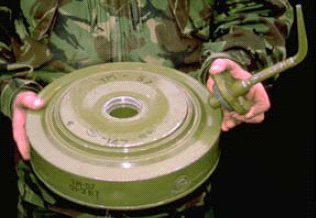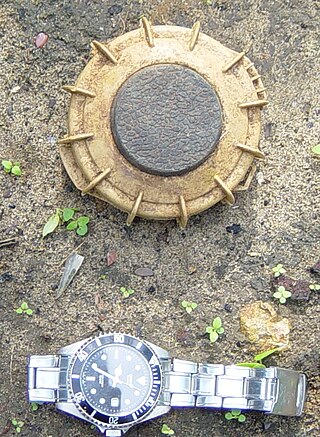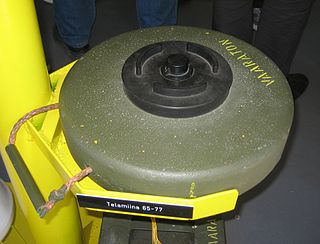The Anti-Tank Mine General Service Mark II was a British anti-tank blast mine used during the Second World War. [1]
The Anti-Tank Mine General Service Mark II was a British anti-tank blast mine used during the Second World War. [1]
It consisted of a body about 7.5 in (190 mm) in diameter and 3.25 in (83 mm). [1] The mine has a central fuze well accessed from the bottom, with a main charge in a cavity around the well consisting of about 4 lb (1.8 kg) of TNT. The mine is fitted with a thin brass cover, which acts as a pressure plate. The cover is suspended over the main body of the main by four leaf springs. A Sorbo ring (Sorbo rubber sponge) can be fitted between the cover and the mine body, which absorbs shock and blast and allows the mines to be planted as close as two feet (0.61 m) without causing sympathetic detonation (normally five feet is the minimum safe distance).
Sufficient pressure - 350 lbf (1.6 kN) - on the cover of the mine causes the cover to press downward onto the pressure cap of the fuze. This downward pressure forces the assembly surrounding the striker down until the striker retaining balls are aligned with a cavity. The balls are pushed aside and the striker is released impacting the detonator which detonates the C.E. pellet, triggering the exploder and then the main charge.
The mine was effective against vehicles and capable of taking off the track of tanks up to medium tank size. [1] The mines main charge was relatively small and the mine appears to have been withdrawn by the end of the war, being replaced by the larger Mk 5 mine. The mine was used in large numbers at the 1942 Second Battle of El Alamein. [2]
Type 72 Non-Metallic is a Chinese circular, plastic bodied landmine which is designed to damage or destroy a vehicle by blast effect.

The Tellermine 42 (T.Mi.42) was a German metal-cased anti-tank blast mine used during the Second World War. The mine was a development of the Tellermine 35 with improved resistance to blast. It was followed by the simplified Tellermine 43. The Tellermine consists of a circular pressed steel main body with a large central pressure plate. The pressure plate is smaller than the earlier Tellermine 35, which increases the mine's resistance to blast. Two secondary fuze wells are provided for anti-handling devices, one in the side, and one on the bottom of the mine. The mine has a carrying handle.

The Tellermine 43 was a German circular steel cased anti-tank blast mine used during the Second World War. It was a simplified version of the Tellermine 42, which enabled simpler production techniques. Between March 1943 and the end of World War II, over 3.6 million Tellermine 43s were produced by Germany. Copies of the mine were produced by several countries including Denmark (M/47), France and Yugoslavia (TMM-1).

The PROM-1 is a Yugoslavian manufactured bounding anti-personnel mine. It consists of a cylindrical body with a pronged fuze inserted into the top of the mine. It is broadly similar in operation to the German S-mine.

The TM-57 mine is a large, circular Soviet metal-cased blast anti-tank mine. It can either be triggered by a pressure or a tilt-rod fuze. A development of the TM-46 mine, it is found in Africa, the Middle East, and South East Asia.

The PMN series of blast anti-personnel mines were designed and manufactured in the Soviet Union. They are one of the most widely used and commonly found devices during demining operations. They are sometimes nicknamed "black widow" because of their dark casings.

The VS-50 is a circular plastic-cased anti-personnel blast mine that entered production in 1985. It was formerly made by the now-defunct Valsella Meccanotecnica SpA, an Italian high-tech defence company specialized in area denial systems. The company also the made the Valmara 69, and was one of the first to implement plastic construction for landmines. The VS-50's design is similar to that of the TS-50 and VS-MK2 mines. It is blast resistant and can be used in a minimum metal configuration. Though unlikely to kill, its explosive charge is quite sufficient to destroy the victim's foot, being capable of penetrating 5 mm of mild steel leaving an 80 mm-diameter hole.

The Panssarimiina m/36 is a Finnish anti-tank blast mine used during the Winter War, Second World War and Continuation War. The mine was the first purpose-built anti-tank mine to enter service with the Finnish Army, and was designed by Lieutenant Colonel T. Raatikainen and Lieutenant Colonel Pylkkänen. Only 5,000 were produced, as the mine proved complex to produce for a number of reasons. The fuze was complex and designed to be interchangeable with artillery fuzes, so artillery shells could be used alongside the mines, also the sheet metal case was hard to produce.

The Panssarimiina m/44 is a Finnish anti-tank blast mine. It entered service in 1944 and was used during the Second World War and Continuation War. The mine used a wooden case, consisting of an upper box containing the main charge and a downward facing fuze, this was placed into a sturdy wooden tray, larger than the box. Enough pressure on the upper box resulted in the upper box collapsing into the lower tray and triggering the detonator.

The M1, M1A1 and M4 are circular steel cased United States anti-tank blast mines with a distinctive cross shaped pressure spider. The mine was used during the Second World War and a copy produced in Argentina was used during the Falklands War. Another copy is produced in China, there designated as the No. 4 mine. Variants of the mine have also been deployed in Chad and Tunisia.
The M6, M6A1 and M6A2 are a series of metal-cased, circular, heavy anti-tank landmines produced by the United States from May 1944 to May 1945.
The Mk 7 mine was a circular British anti-tank blast mine. It replaced the World War 2-era Mk 5 mine, and has in turn been replaced by the L9 bar mine.

The TM 65 is a circular Finnish minimum metal anti-tank blast mine. It is broadly based on the Russian TM-62 mine. The mines body is made from a thin shell of fibreglass over a cast block of explosive, with a central fuze well that holds the pressure fuze. The original TM 65 used a US-65 fuze as used in the SM-65 anti-personnel mine, the later TM 65 77 uses a pressure fuze similar to the Russian MV-5 fuze called Painesytytin 77.

The Pappmine, or Cardboard Mine in English, was an anti-tank mine that was developed by Germany and used by the Wehrmacht during World War II.

The L.P.Z. mine or Leichte Panzermine was a circular, metal-cased German anti-tank mine produced during the Second World War. The mine was accepted into service in 1941, and were intended for use by Paratroops. Production of the mine ended in 1942 with only 31,700 mines produced. The mines were first used during Operation Merkur, the airborne invasion of Crete and were still in use at the end of the war.

The Pignone mod.43 were bakelite cased Italian anti-tank blast mines used during the Second World War in North Africa and Italy.
The TMK-2 is a Soviet steel cased anti-tank mine. It uses a tilt-rod fuze combined with a shaped charge to attack the belly of vehicles as they pass over the mine. It was originally designed in 1955, but is now obsolete. The mine consists of a case shaped like two truncated cones joined at the base. The MVK-2 tilt rod assembly is held to one side of the mine. The lower truncated cone contains the main charge, and dished metal charge liner.
The Anti-Tank Mine, General Service, Mark IV was a British anti-tank mine used during World War II. Externally the mine has a cylindrical main body filled with explosive either TNT or Baratol. The mine is covered by a pressure plate, which is attached to the mine body by four pins which sit in vertical slots in clips that fold up from the bottom of the mine. The mine uses the Shear-pin based Contact Mine Fuze No.3 Mk I. The fuze consists simply of a spring-loaded striker pin restrained by a shear pin. Sufficient pressure on the pressure plate presses the plate down on the head of the fuze, breaking the shear wire and releasing the striker, which is driven into the detonator by the striker spring.

The TMRP-6 is a former Yugoslavian anti tank EFP mine.

The B-Stabmine (Behelfs-Stabmine) or Makeshift Stickmine in English was an anti-tank mine that was developed by Germany and used by the Wehrmacht during World War II.